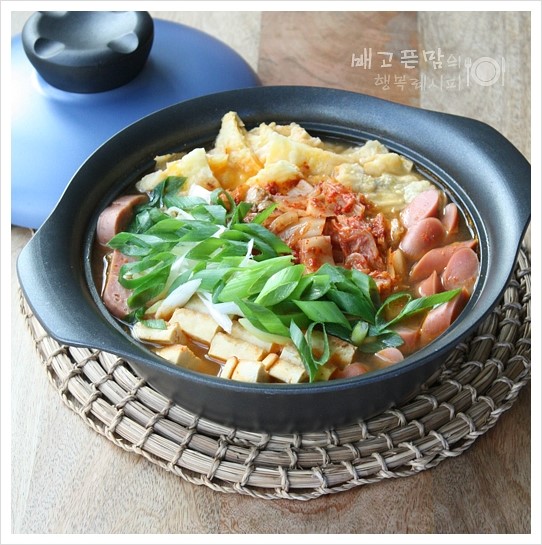Spam and Savory Jeon Kimchi Stew
Hearty and Spicy Kimchi Stew Made with Leftover Holiday Jeon

This Spam Kimchi Stew recipe is made even more satisfying and flavorful by utilizing leftover dubu jeon (tofu pancakes) and myungtae jeon (pollack pancakes) from the Chuseok holiday. Packed with kid-favorite Spam and sausages, and seasoned with well-fermented kimchi, this stew tastes remarkably like a budae jjigae (army base stew), offering a spicy and refreshing broth that soothes the palate after rich holiday meals. Make a delicious bowl that will gently comfort your stomach.
Main Ingredients- 150g Dubu Jeon (Tofu Pancake), about 3 pieces
- 200g Myungtae Jeon (Pollack Pancake), about 7 pieces
- 200g Spam
- 5 Frankfurters (140g)
- 2.5 cups (350g) Aged Kimchi
- 4 cups Rice Water
- 1 stalk Green Onion
Seasoning- Pinch of Salt
- Pinch of Black Pepper
- Pinch of Salt
- Pinch of Black Pepper
Cooking Instructions
Step 1
First, prepare 3 pieces of dubu jeon (tofu pancake, about 150g) and 7 pieces of myungtae jeon (pollack pancake, about 200g) that are leftover from the holiday. If you don’t have jeon, you can omit it or substitute with other types of jeon.

Step 2
Next, prepare 1 can of Spam (200g) and 5 frankfurters (140g), which are popular with children. Slice the Spam into bite-sized pieces, and score or slice the sausages.

Step 3
Arrange the prepared dubu jeon, myungtae jeon, Spam, and sausages attractively around the edges of a ttukbaegi (earthenware pot). This arrangement helps the ingredients meld together nicely as they cook.

Step 4
Now, slice the aged kimchi (2.5 cups, 350g) into bite-sized pieces and place it generously in the center of the ttukbaegi. Feel free to adjust the amount of kimchi according to your preference.

Step 5
Pour 4 cups of rice water over the ingredients, ensuring the kimchi is submerged. Using rice water adds a richer, deeper flavor to the broth.

Step 6
Place the ttukbaegi on the stove over high heat and bring the contents to a rolling boil. Covering the pot will help it boil faster.

Step 7
Once the broth is boiling and the flavors have melded, skim off any scum that rises to the surface. Then, add 1 stalk of diagonally sliced green onion and simmer for another moment. Finally, season with salt and pepper to taste. For me, the seasoning was perfect at this point.

Step 8
Unlike the rich tangguk (traditional soup) often eaten during holidays, this spicy and refreshing kimchi stew, which isn’t heavy, will nicely cleanse your palate. Enjoy it with a warm bowl of rice!




